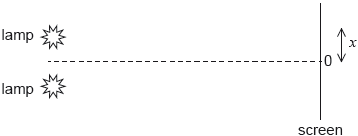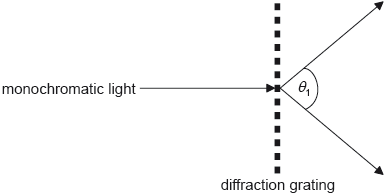| Date | May 2019 | Marks available | 3 | Reference code | 19M.2.HL.TZ2.8 |
| Level | Higher level | Paper | Paper 2 | Time zone | 2 |
| Command term | Deduce | Question number | 8 | Adapted from | N/A |
Question
Monochromatic coherent light is incident on two parallel slits of negligible width a distance d apart. A screen is placed a distance D from the slits. Point M is directly opposite the midpoint of the slits.
Initially the lower slit is covered and the intensity of light at M due to the upper slit alone is 22 W m-2. The lower slit is now uncovered.
The width of each slit is increased to 0.030 mm. D, d and λ remain the same.
Deduce, in W m-2, the intensity at M.
P is the first maximum of intensity on one side of M. The following data are available.
d = 0.12 mm
D = 1.5 m
Distance MP = 7.0 mm
Calculate, in nm, the wavelength λ of the light.
Suggest why, after this change, the intensity at P will be less than that at M.
Show that, due to single slit diffraction, the intensity at a point on the screen a distance of 28 mm from M is zero.
Markscheme
there is constructive interference at M
OR
the amplitude doubles at M ✔
intensity is «proportional to» amplitude2 ✔
88 «W m−2» ✔
« ✔
» ✔
«the interference pattern will be modulated by»
single slit diffraction ✔
«envelope and so it will be less»
ALTERNATIVE 1
the angular position of this point is «rad» ✔
which coincides with the first minimum of the diffraction envelope
«rad» ✔
«so intensity will be zero»
ALTERNATIVE 2
the first minimum of the diffraction envelope is at «rad» ✔
distance on screen is «mm» ✔
«so intensity will be zero»
Examiners report
This was generally well answered by those who attempted it but was the question that was most left blank. The most common mistake was the expected one of simply doubling the intensity.
This was very well answered. As the question asks for the answer to be given in nm a bald answer of 560 was acceptable. Candidates could also gain credit for an answer of e.g. 5.6 x 10-7 m provided that the m was included.
Many recognised the significance of the single slit diffraction envelope.
Credit was often gained here for a calculation of an angle for alternative 2 in the markscheme but often the final substitution 1.50 was omitted to score the second mark. Both marks could be gained if the calculation was done in one step. Incorrect answers often included complicated calculations in an attempt to calculate an integer value.




